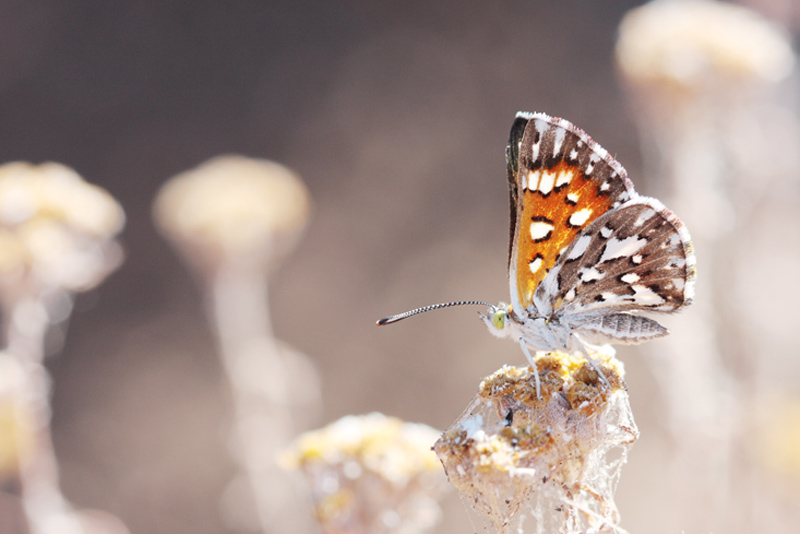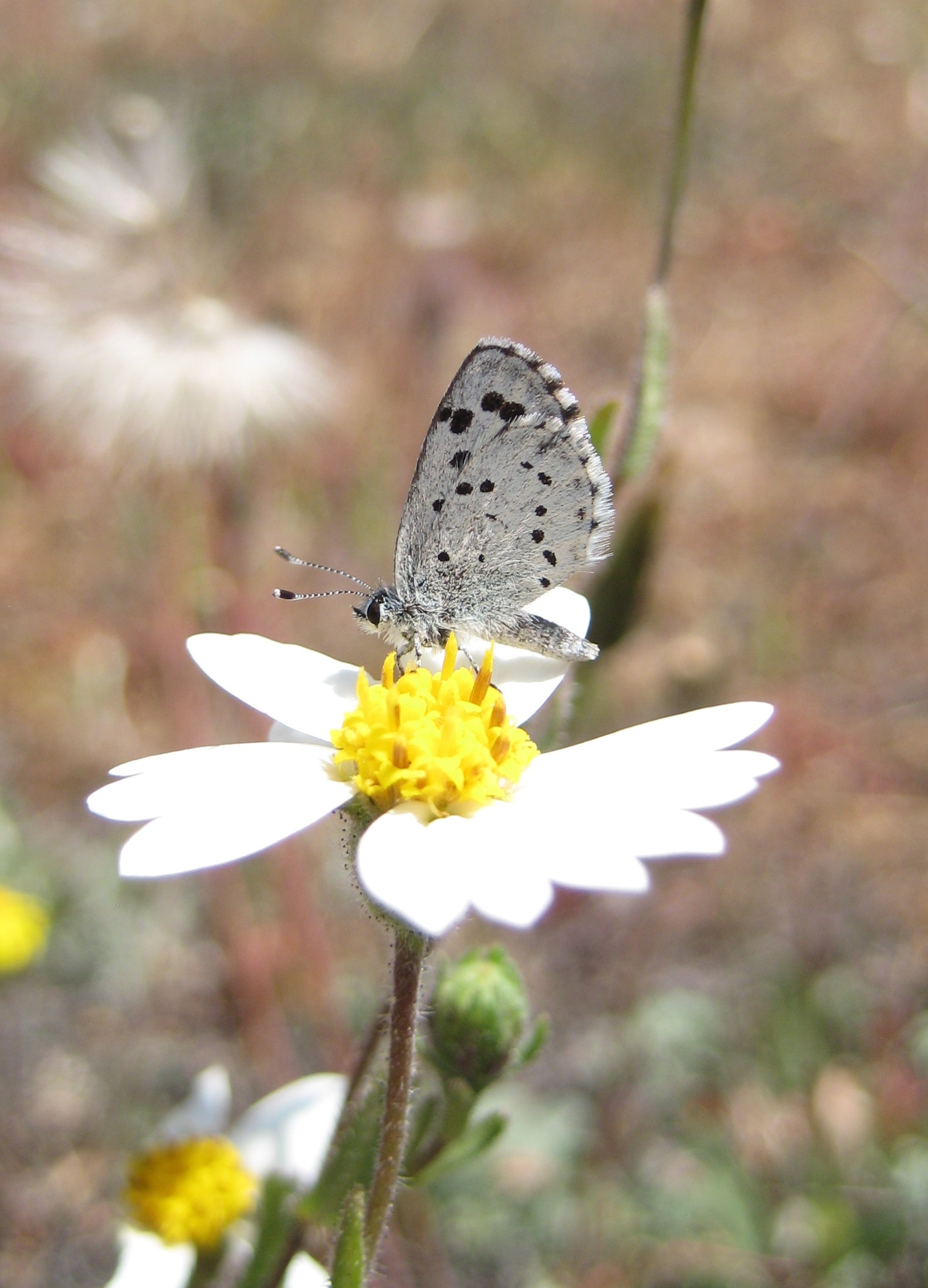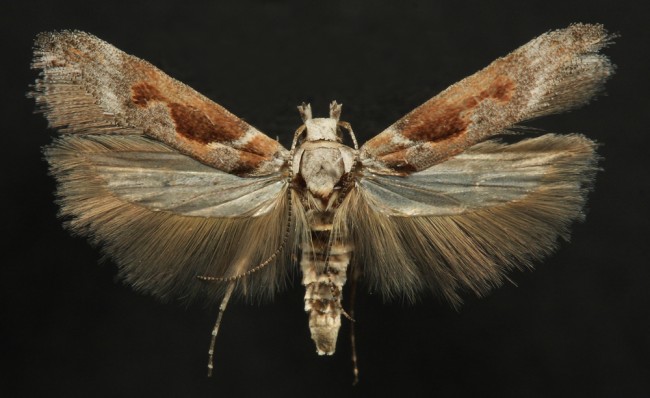Przez Chris Grinter, on February 24th, 2010

Know this butterfly? It’s OK, no one really does. It is in the genus Apodemia (Riodinidae), but the taxonomy of this group is a disaster… and don’t even get me started on the subspecies. This specimen was photographed in September, meaning it is most likely to be Apodemia mormo (mormo) based on flight time. A. mormo is a fall flyer and A. virgulti is a spring flyer. While some forms seem distinctive, there is massive morphological overlap and they are usually identical and sympatric – actually down to living on the same plants. But according to lab experiments it is impossible to get the pupae to break diapause so they remain reproductively isolated. So are they different? While molecular work is being conducted the verdict is out, but it does seem like these two species may be retained in the end. I oczywiście, each mountain range has it’s own subspecies. Who knows, I sure don’t. I’m glad I don’t work on butterflies.
Species concepts are a fuzzy line and it’s never clear exactly where to make the cut. When asked what a species is most people default to the Mayr concept of Biological Species (BSC), where reproductive isolation = new. This is all well and good but we have to keep in mind that this is not the ONLY species concept. Są dozens, and not one is perfect. Groups like Grammia (Noctuidae: Arctiinae) exhibit high levels of hybridization, which does not adhere well to the BSC. I like to apply as many criteria as possible to delimit a species and it seems like the line is all too commonly thin within insects. I like to see a distinguishing morphological trait, if not in wing color or pattern, at the least in the genitalia or antennae. This is not always the case however and you have to look at the biology and/or DNA. I have looked at two insects that are for all intents and purposes identical. But the biology is radically different and a large % difference (nad 8% – tak, arbitrary) in their DNA makes it unquestionable that they are separate.
And if species weren’t contentious enough subspecies stir the pot even more. I’m skeptical about the entire concept, but there are cases in which it seems plausible and necessary. A subspecies is a more formal definition of a geographical “Formularz” and usually exhibits a blend zone into another subspecies. For instance if you look at the 27 different populations of Plebejus icarioides there are large differences between northern and southern populations, but very subtile difference along the gradient. It is that persistent gradient that creates one dynamic species instead of 27 separate species – at least according to current research. Moths have been lucky and have thus far avoided the plague of over-subspeciation, butterflies not so much. There may even be instances where greedy collectors have named new subspecies of Parnassius for profit (new rare butterfly subspecies sell for big bucks).
The truth is that species concepts are artificial, poorly understood and dynamic at best; at worst it approaches a soft science with no real possibility of proof. Yet species are real and theories will continue to adapt while we sit here and scratch our heads.
Przez Chris Grinter, 23 lutego, 2010 

Jedną z zalet bycia entomolog podróżuje i zbierania. I umieścić kilka tysięcy mil w samochodzie każdego lata i są to jedne z najlepszych miejsc w Arizonie do zbierania. Obraz jest z najwyższej góry Baboquivari (Baboquivari Szczyt w środku), Stacja Badawcza brązowy Kanion. Dolny obraz jest Peña Blanca Canyon, Słynny zbieranie hotspot. To jest tylko kanion 5 km od Meksyku i ma kilka problemów bezpieczeństwa, ponieważ z naszej obecnej polityki imigracyjnej. Pewnego ranka, podczas sortowania ćmy z poprzedniej nocy złapać, kolega i ja mieliśmy grupę około 30 nielegalnych walk w prawo w naszym obozie. Byli dobrze ubrani i czyste, pomachał, i musi właśnie odpadły w płot. Na szczęście większość nielegalnych imigrantów są pracowici i uczciwi ludzie próbują zarobić na lepsze życie. To kojoty i przemytników, które są przerażające – Słyszałem opowieści o meksykańskich policjantów eskortujących karawany narkotyków do USA z ciężkiej artylerii. I tak w zeszłym roku środek Border Patrol został zasztyletowany przez kojota w tej okolicy.
Na szczęście, banda dziwnych facetów stojących wokół dziwne światła w nocy daje nam szerokim łukiem.
(Obrazy te są na tyle małe, aby szybko załadować?)
Przez Chris Grinter, 23 lutego, 2010 Despite being pretty disinterested in butterflies, they are pretty to look at. Here is a really great video by a guy I know down in Southern CA. His time-lapse videos of lepidoptera life cycles are pretty impressive, and this one in particular is beautiful. If you cut to about 3:00 w, you will see dozens of Great Purple Hairstreaks (Atlides halesus) emerging from their chrysalises, the colors are stunning. This butterfly is native to the SW and Mexico, and I have to admit I love finding it in the field.
[youtube=http://www.youtube.com/watch?v=KyWJlpIchkE]
Przez Chris Grinter, 23 lutego, 2010 The brief comment about Linus Pauling and Vitamin C below made me remember this video first posted a while ago by pharyngula. This is Kary Mullis, the inventor of PCR, and a Nobel Prize winner. His invention basically made DNA analysis possible. But like Pauling, he is also completely and totally nuts. If you have the time to listen to him ramble, give it a shot. But in short, he discusses astrology, denies global warming and how AIDS is not caused by HIV. I wonder what the stats are for genius scientists that slide off their rocker?
[Vimeo 9167379]
Przez Chris Grinter, 22 lutego, 2010 
To jest mój stary obraz, więc nie jest idealnie. Jeśli powiesz mi tego motyla gatunkom, przybijesz piątkę. Jeśli znasz podgatunek, wyślę ci nową paczkę #3 szpilki ze stali nierdzewnej! Tylko podpowiedź: Pochodzi z zachodnich Stanów Zjednoczonych.
Przez Chris Grinter, 22 lutego, 2010 Today I found to article in NY times health – zachwalać zalety akupunktury używane do łagodzenia depresji u kobiet w ciąży. Mam kilka problemów z dziennikarzem, Shirley S. Pieniądze, braku pozostać sceptyczny w swoim kawałku. Ale to nie dziwi,, so I won’t bother to point out obvious flaws in the media.
I will point out the flaws in the study. Please find the original full text, tutaj. So after reading this paper I have come to a few conclusions.
1) Very small sample size of 150 patients, tylko 141 treated.
2) The study is blinded ONLY for the depression scoring, not administration of acupuncture. In fact, their release form states “Participants in one of these two groups will receive acupuncture that focuses on depression symptoms and the other treatment will not.” Makes sense, getting a needle shoved in your skin is easy to notice. Tak, these “randomized and blinded” participants knew what was coming and assumed that any poking was supposed to help their depression. Ponadto, to (much better) study has shown that simulated acupuncture with toothpicks works just the same. Careful, this is compelling evidence against the validity of acupuncture – not evidence for the usefulness of stimulated “pressure points”. It is a placebo effect.
3) Study assumes validity of “depression specific” i “non-specific” acupuncture. Meaning one method of pin sticking somehow cures depression over another. What is this based on? Oh wait, they say exactly the exhaustive scientific evidence right here: “patterns of disharmony according to the principles of traditional Chinese medicine”. I’m sorry, please, give me modern medicine over 2,000 year old mythical beliefs. How was the average quality of life and life expectancy for an ancient chinese person? Pretty damn horrible, and I’m sure the average life expectancy did not exceed 35 roku.
4) Basing depression scores on one administration of the DSM-IV Hamilton Rating Scale. Not being a psychiatrist I can’t speak to the efficacy of these tests. Ale, I will go out on a limb and assume that a stronger baseline for depression should be established before comparing results. The test may be accurate, but why not administer it more than once to reduce noise.
5) Selection of massage as a second control. This is a bad attempt at token skepticism, they even state right off the bat “Massage was conceptualized as a control treatment because, although it improves mood immediately after a session, there is insufficient evidence to support its efficacy as a treatment for depression.” When I design a study I like to look at all known factors that I believe will disprove my hypothesis. Choosing something that you already believe will fail only shows their hand of gross bias.
6) Failure to control for socioeconomic factors. 67% of the participants were white, the majority of which were well-educated. They even go as far as to state in the discussion “Therefore, results might not generalize to specific minority groups that were underrepresented in our sample”. Is it just me, or does this statement negate the entirety of their research? They are freely admitting that acupuncture might not work as well in other minority groups. Why could this be? The only logical and scientific answer is that a placebo effect differs across socioeconomic boundaries. If, after all, acupuncture was a legitimate medical science, there would be an insignificant difference seen across physiologically identical organisms.
This study is appallingly bad science. These researchers are beginning with the premise that acupuncture works, and searching for data to support their claims. This is exactly opposite of how to conduct real science. I, our health reporter at the NY Times didn’t even bat an eye. Fail for you Mrs. Pieniądze, and fail to the NY Times.
Przez Chris Grinter, on February 21st, 2010 Uwielbiam Ming Tsaia i jego kulinarne imperium tak samo, jak następny widz o 3 nad ranem. Faktycznie, jego przepisy są fantastyczne i powinieneś zrób je sam. Ale zauważyłem u niego dziwną tendencję do mówienia (parafrazowany) “zawsze powinieneś używać organicznych, tak jest znacznie lepiej dla ciebie”. To mnie trochę zdziwi. Co dokładnie ma na myśli?? Ming jest dobrze wykształcony i nie jest to coś, za co powinien być wyłącznie odpowiedzialny, ale powtarza zbyt powszechne błędne przekonanie, że produkty organiczne są w rzeczywistości lepsze. Lepiej interpretuję to jako zdrowsze, co wydaje się być logiczną luką w mostku. Tak, spójrzmy na dane.
Ostatnia i obszerna recenzja opublikowana w American Journal of Clinical Nutrition w dużej mierze przekonało mnie do tego, do czego zawsze byłam sceptycznie nastawiona; że żywność ekologiczna nie może być dla Ciebie zdrowsza. W swoim załamaniu cytowali 55 studia i doszedł do wniosku, że “nie ma dowodów na różnicę w jakości składników odżywczych między żywnością produkowaną ekologicznie i konwencjonalnie”.
Więc jaka jest szkoda?? Mój problem z tym wszystkim polega na tym, że opiera się na błędzie naturalistycznym, że “naturalny” lub “organiczny” w jakiś sposób oznacza, że produkt jest bezpieczniejszy lub zdrowszy. Ile razy widzisz ten termin “naturalny” w sklepie i nigdy nie zastanawiaj się nad tym? Jeśli naturalne rzeczy naprawdę były bezpieczniejsze niż tradycyjne Ajurwedy leki nie byłyby strasznie toksyczne. W sumie, arsen, ołów i rtęć są NATURALNE – ale są też jednymi z najbardziej toksycznych związków znanych człowiekowi. W końcu jest 100% marketing.
Ming Tsai z innej perspektywy może wcale nie być aż tak niepoprawny. Nie mam przed sobą wszystkich danych dotyczących skażenia żywności pestycydami, ale logiczne jest założenie, że im mniej zanieczyszczone, tym lepiej. Oczywiście pestycydy mogą być zła rzecz, istnieją góry literatury na poparcie szkód, jakie mogą wyrządzić. Ale ława przysięgłych wydaje się dokładnie wiedzieć, jak źle, jeśli w ogóle, te drobne pozostałości na naszej żywności są. Żywność uprawiana konwencjonalnie ma poziomy regulowane pozostałości, ale nawet organiczne nie są wolne od skażenie pestycydami. Więc patrzę na to inaczej. Nasze środowisko czerpie korzyści z posiadania bezpieczniejszej żywności. Mniej chemikaliów trafia do naszych dróg wodnych, rolnicy muszą mniej walczyć z niewiarygodnie silnymi toksynami, i mrugający ryby walczą o kolejny dzień. Wszyscy powinniśmy dążyć do zrównoważonego życia, a rolnictwo ekologiczne zapewnia nam przewagę.
Więc jeszcze raz, jaka jest szkoda?? Ludzie, którzy kupują produkty ekologiczne, prawdopodobnie robią to w oparciu o autentyczne zarządzanie środowiskiem. Twierdzę również, że bardzo wysoki odsetek tych osób również uważa, że te produkty są zdrowsze (każdy ma dane ankietowe na poparcie tego twierdzenia?). Więc w tym przypadku wynik jest dodatni netto. Ale, słuszność ze złych powodów nigdy nie powinna być akceptowalna. Uderza to w sedno większego problemu, który jest napędzany przez marketing i zero-naukę. Przykładem – Witamina C jako lek na przeziębienie. Studium w PLOS medycyna wykazał, że nie ma wskazań do skuteczności VitC w walce z przeziębieniem. Domyśl, kiedyś uważana za prawdziwą podstawę, zaczęła być rozdzielana przez naukę i dane. Uważajmy na to, jaką modą skaczemy i dlaczego.
Przez Chris Grinter, on February 21st, 2010 [youtube=http://www.youtube.com/watch?v=zSgiXGELjbc]
I really enjoy this autotuned Sagan, makes me with I was this eloquent. Watch more videos here at the Symphony of Science.
Przez Chris Grinter, on February 21st, 2010  Tak, how do I begin a new blog? Tough question, but perhaps this is a good time to show off a fun new species. This moth was collected last year outside of Santa Barbara, Kalifornia. The massive wingspan, at 15mm, makes it pretty large for a Gelechiid moth. The genus, Gnorimoschema (pronounced nor-a-mosh-ma), seems to be far more species rich than is currently known, so this creature comes as no surprise. It also gives me a chance to brag about the benefits of studying such a wonderfully diverse group of animals. If you happen to be lucky enough to be a friend of mine you’ll probably get your own species at some point. Tak, how do I begin a new blog? Tough question, but perhaps this is a good time to show off a fun new species. This moth was collected last year outside of Santa Barbara, Kalifornia. The massive wingspan, at 15mm, makes it pretty large for a Gelechiid moth. The genus, Gnorimoschema (pronounced nor-a-mosh-ma), seems to be far more species rich than is currently known, so this creature comes as no surprise. It also gives me a chance to brag about the benefits of studying such a wonderfully diverse group of animals. If you happen to be lucky enough to be a friend of mine you’ll probably get your own species at some point.
Z drugiej strony, this also highlights the problem – knowing almost nothing about the most diverse group of animals on our planet. What happens when a new crop is being eaten by a tiny, nondescript, moth? Call one of the dozen people in the world who might be able to help you. Maybe they know what it is, but likely nothing is known about its biology. This is what happened in South Dakota recently when biofuel crops were being eaten by a moth last seen in 1910. What a perfect reason for more funding! More likely than not my new moth above will never explode into a pest. But having basic knowledge of the species that share this earth with us is a step in the right direction.
|
Sceptycyzm
|





